Analytical Design Solution for Optimal Matching of Hybrid Continuous Mode Power Amplifiers Suitable for a High-Efficiency Envelope Tracking Operation
Abstract
1. Introduction
2. Feasible Design Space for ET Operation
2.1. Nonlinear Capacitance and Parasitic Model
2.2. Dynamic Envelope Supply Voltage
2.3. HCM PAs Design Space for PAE Trajectory Optimization
2.4. PA Implementation and Test
3. Envelope Tracking Transmitter Experimental System
3.1. High Efficiency and Wideband Hybrid Envelope Amplifier
3.2. Measurement Setup
4. Measurement Results
5. Conclusions
Author Contributions
Funding
Acknowledgments
Conflicts of Interest
References
- McKnight, K.; Darwish, A.; Zaghloul, M. A Compact Output Power Combiner for Broadband Doherty Power Amplifiers. Electronics 2019, 8, 275. [Google Scholar] [CrossRef]
- Ramella, C.; Piacibello, A.; Quaglia, R.; Camarchia, V.; Pirola, M. High Efficiency Power Amplifiers for Modern Mobile Communications: The Load-Modulation Approach. Electronics 2017, 6, 96. [Google Scholar] [CrossRef]
- Tena-Ramos, D.; Patino-Gomez, M.; Ortega-Gonzalez, F.J. Hybrid Envelope Elimination and Restoration Technique for Enhancing the Linearity of Switchmode Envelope Amplifiers. IEEE Microw. Wirel. Components Lett. 2017, 27, 186–188. [Google Scholar] [CrossRef]
- Asbeck, P.; Popovic, Z. ET Comes of Age: Envelope Tracking for Higher-Efficiency Power Amplifiers. IEEE Microw. Mag. 2016, 17, 16–25. [Google Scholar] [CrossRef]
- Jeong, J.; Chaudhary, G.; Jeong, Y. Time Mismatch Effect in Linearity of Hybrid Envelope Tracking Power Amplifier. IEEE Microw. Wirel. Components Lett. 2015, 25, 1. [Google Scholar] [CrossRef]
- Kimball, D.F.; Nakatani, T.; Yan, J.; Mukai, K. Analog & Digital Envelope Tracking Power Amplifier Reduced Bandwidth Techniques for 5G NR. In Proceedings of the Asia-Pacific Microwave Conference (APMC), Kyoto, Japan, 6–9 November 2018; pp. 55–57. [Google Scholar]
- Liu, Y.J.; Yoo, C.S.; Fairbanks, J.; Yan, J.; Kimball, D.; Asbeck, P. A 53% PAE Envelope Tracking GaN Power Amplifier for 20MHz Bandwidth LTE Signals at 880MHz. In Proceedings of the IEEE Topical Conference on Power Amplifiers for Wireless and Radio Applications (PAWR), Austin, TX, USA, 24–27 January 2016; pp. 30–32. [Google Scholar]
- Wang, Y.; Jin, Q.; Ruan, X. Optimized Design of the Multilevel Converter in Series-Form Switch-Linear Hybrid Envelope-Tracking Power Supply. IEEE Trans. Ind. Electron. 2016, 63, 5451–5460. [Google Scholar] [CrossRef]
- Jin, Q.; Ruan, X.; Ren, X.; Wang, Y.; Leng, Y. Step-Wave Switched Capacitor Converter for Compact Design of Envelope Tracking Power Supply. IEEE Trans. Ind. Electron. 2017, 64, 9587–9591. [Google Scholar] [CrossRef]
- Jing, Y.; Bakkaloglu, B. A High Slew-Rate Adaptive Biasing Hybrid Envelope Tracking Supply Modulator for LTE Applications. IEEE Trans. Microwave Theory Tech. 2017, 65, 1–12. [Google Scholar] [CrossRef]
- Xi, H.; Cao, J.; Liu, N.; Ruan, X.B.; Fang, Z.; Ji, B.J. High Bandwidth Envelope Tracking Power Supply with Pulse Edge Independent Distribution Method. IEEE Trans. Ind. Electron. 2019, 66, 5907–5917. [Google Scholar] [CrossRef]
- Huang, F.; Chen, W.; Zhang, Q.; Li, J.; Lv, G.; Feng, Z. A design methodology of envelope tracking power amplifier based on harmonic impedance tuning. Microw. Opt. Technol. Lett. 2018, 60, 639–642. [Google Scholar] [CrossRef]
- Moon, J.; Kim, J.; Kim, B. Investigation of A Class-J Power Amplifier with A Nonlinear Cout for Optimized Operation. IEEE Trans. Microwave Theory Tech. 2010, 58, 2800–2811. [Google Scholar] [CrossRef]
- Komatsuzaki, Y.; Lanfranco, S.; Kolmonen, T.; Piirainen, O.; Tanskanen, J.K.; Sakata, S.; Ma, R.; Shinjo, R.; Yamanaka, K.; Asbeck, P. A High Efficiency 3.6-4.0 GHz Envelope-Tracking Power Amplifier Using GaN Soft-Switching Buck-Converter. In Proceedings of the IEEE/MTT-S International Microwave Symposium (IMS), Philadelphia, PA, USA, 10–15 June 2018; pp. 465–468. [Google Scholar]
- Carrubba, V.; Ture, E.; Quay, R.; Raay, F.; Musser, M.; Ambacher, O. Analysis and Performance of Drain Bias “In-dependent” Class-J Power Amplifier. In Proceedings of the Asia-Pacific Microwave Conference (APMC), Sendai, Japan, 4–7 November 2014; pp. 998–1000. [Google Scholar]
- Chen, J.; He, S.; You, F.; Tong, R.; Peng, R. Design of Broadband High-Efficiency Power Amplifiers Based on a Series of Continuous Modes. IEEE Microw. Wirel. Components Lett. 2014, 24, 631–633. [Google Scholar] [CrossRef]
- Tasker, P.; Benedikt, J. Waveform Inspired Models and the Harmonic Balance Emulator. IEEE Microw. Mag. 2011, 12, 38–54. [Google Scholar] [CrossRef]
- Jeong, J.; Kimball, D.; Kwak, M.; Hsia, C.; Draxler, P.; Asbeck, P. Modeling and Design of RF Amplifiers for Envelope Tracking WCDMA Base-Station Applications. IEEE Trans. Microwave Theory Tech. 2009, 57, 2148–2159. [Google Scholar] [CrossRef]
- Tuffy, N.; Guan, L.; Zhu, A.; Brazil, T.J. A Simplified Broadband Design Methodology for Linearized High-Efficiency Continuous Class-F Power Amplifiers. IEEE Trans. Microwave Theory Tech. 2012, 60, 1952–1963. [Google Scholar] [CrossRef]
- Kimball, D.; Jeong, J.; Hsia, C.; Draxler, P.; Lanfranco, S.; Nagy, W.; Linthicum, K.; Larson, L.; Asbeck, P. High-Efficiency Envelope-Tracking W-CDMA Base-Station Amplifier Using GaN HFETs. IEEE Trans. Microwave Theory Tech. 2006, 54, 3848–3856. [Google Scholar] [CrossRef]
- Cao, T.; Huang, F.; Zhang, Q.; Liu, Y.J. High Efficiency and Wideband Hybrid Envelope Amplifier for Envelope Tracking Operation of Wireless Transmitter. In Proceedings of the IEEE/MTT-S International Wireless Symposium (IWS), Chengdu, China, 6–10 May 2018; pp. 1–4. [Google Scholar]
- Kim, D.; Kang, D.; Choi, J.; Kim, J.; Cho, Y.; Kim, B. Optimization for Envelope Shaped Operation of Envelope Tracking Power Amplifier. IEEE Trans. Microwave Theory Tech. 2011, 59, 1787–1795. [Google Scholar] [CrossRef]
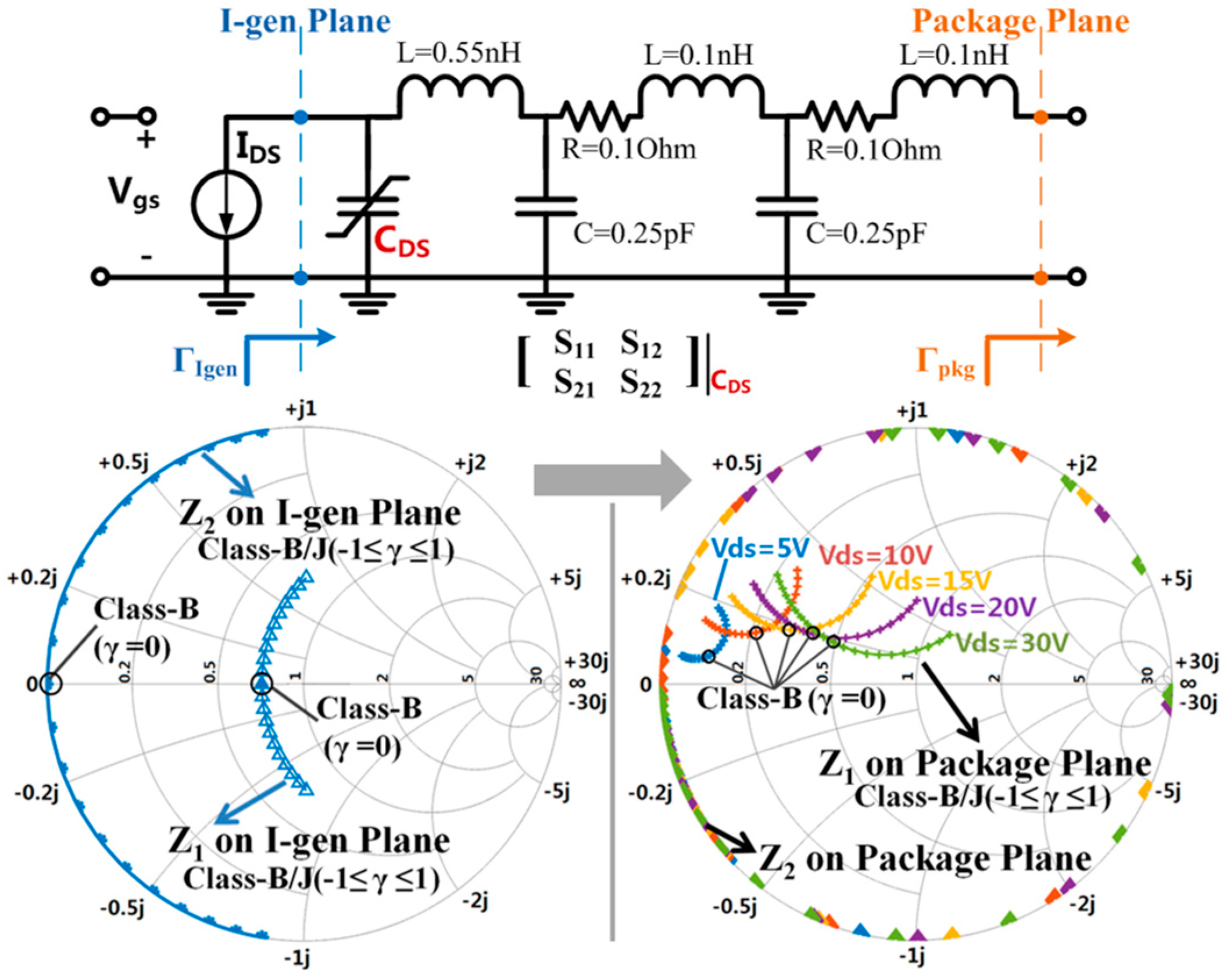
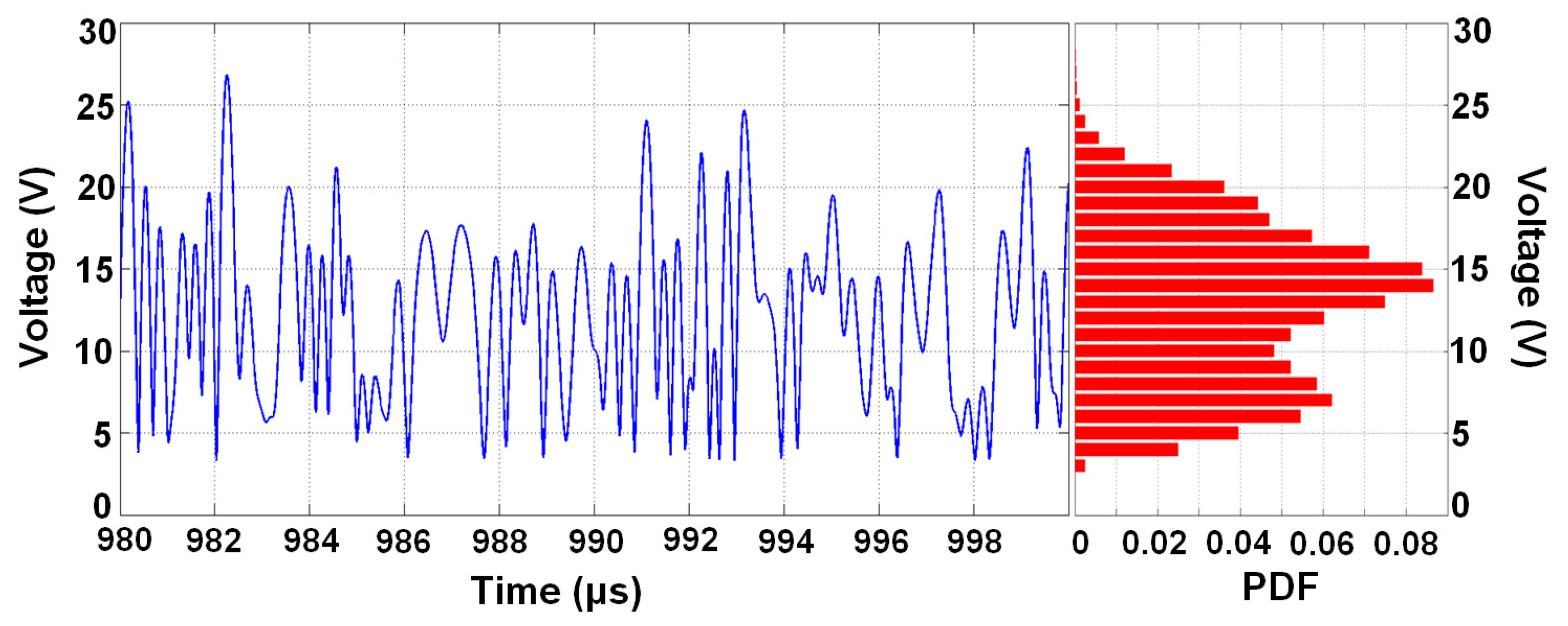
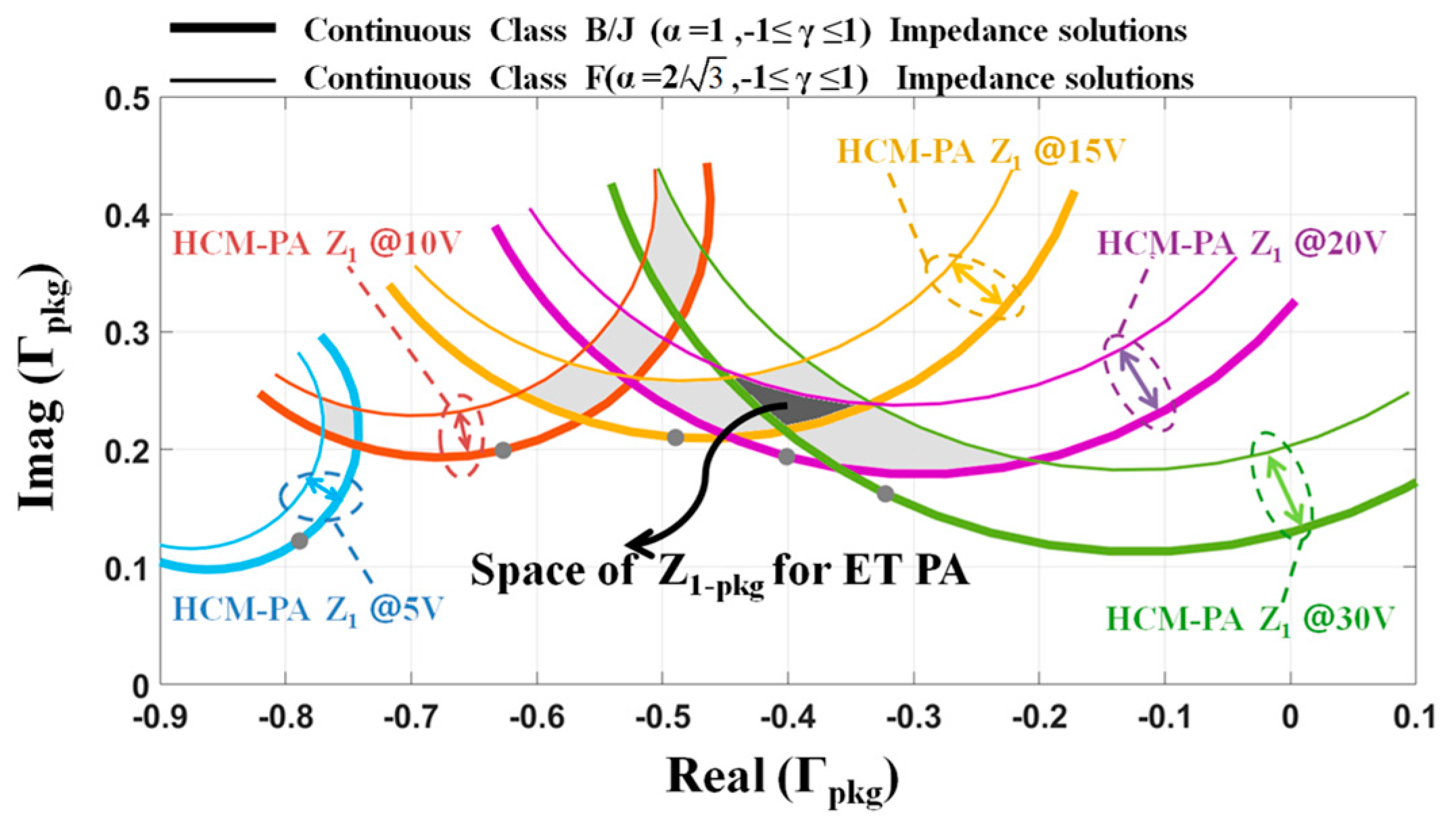
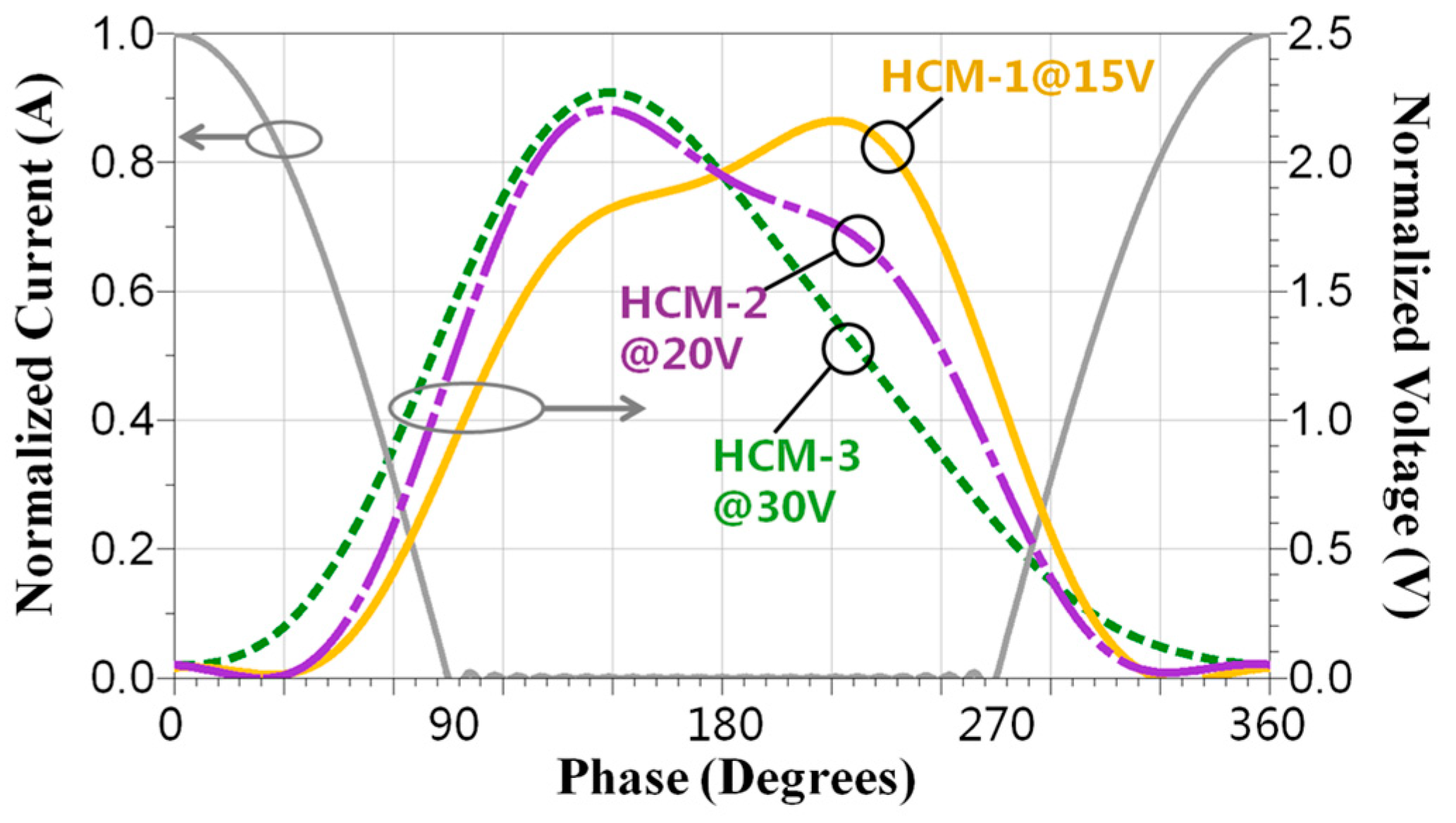

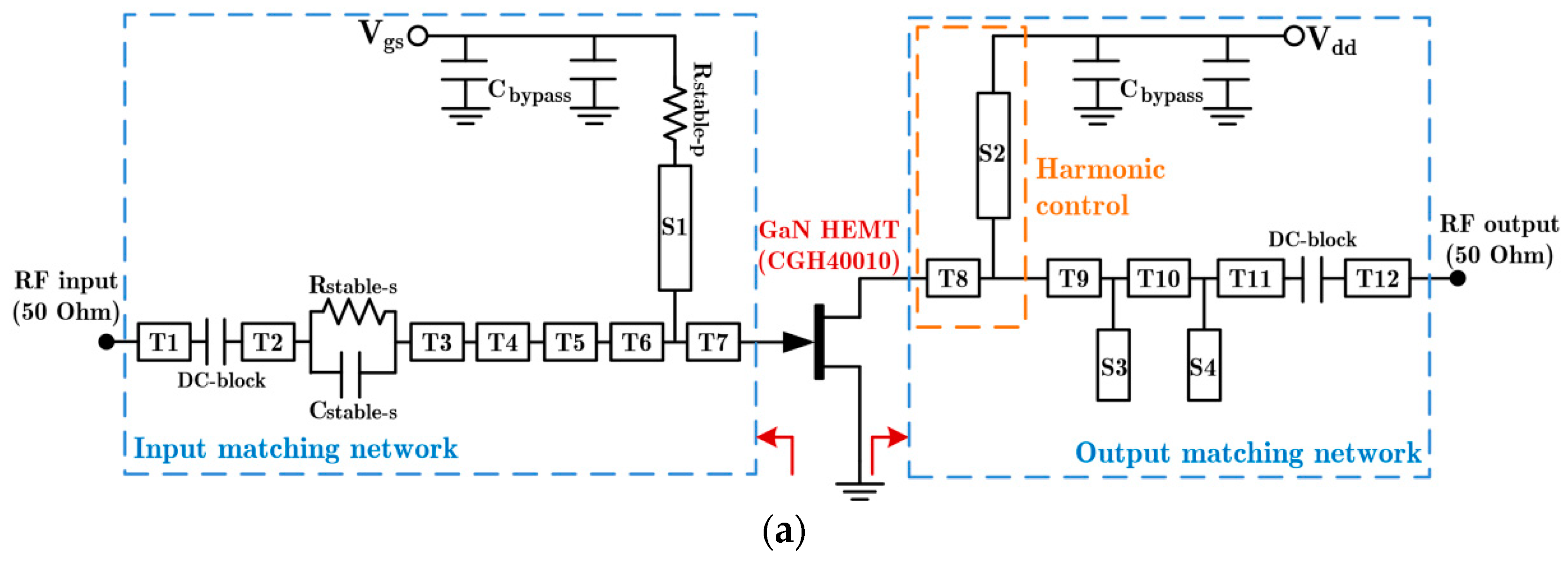
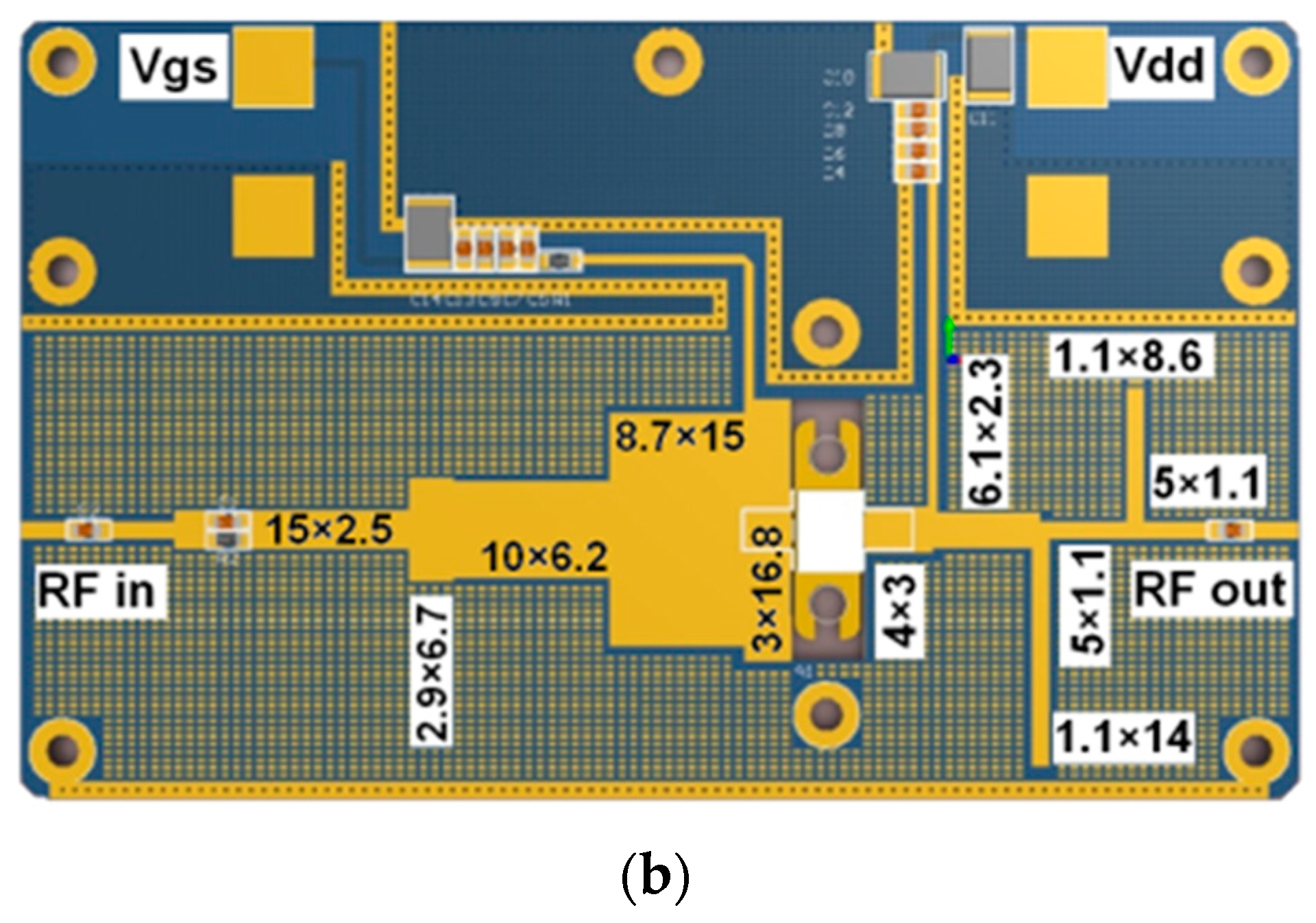

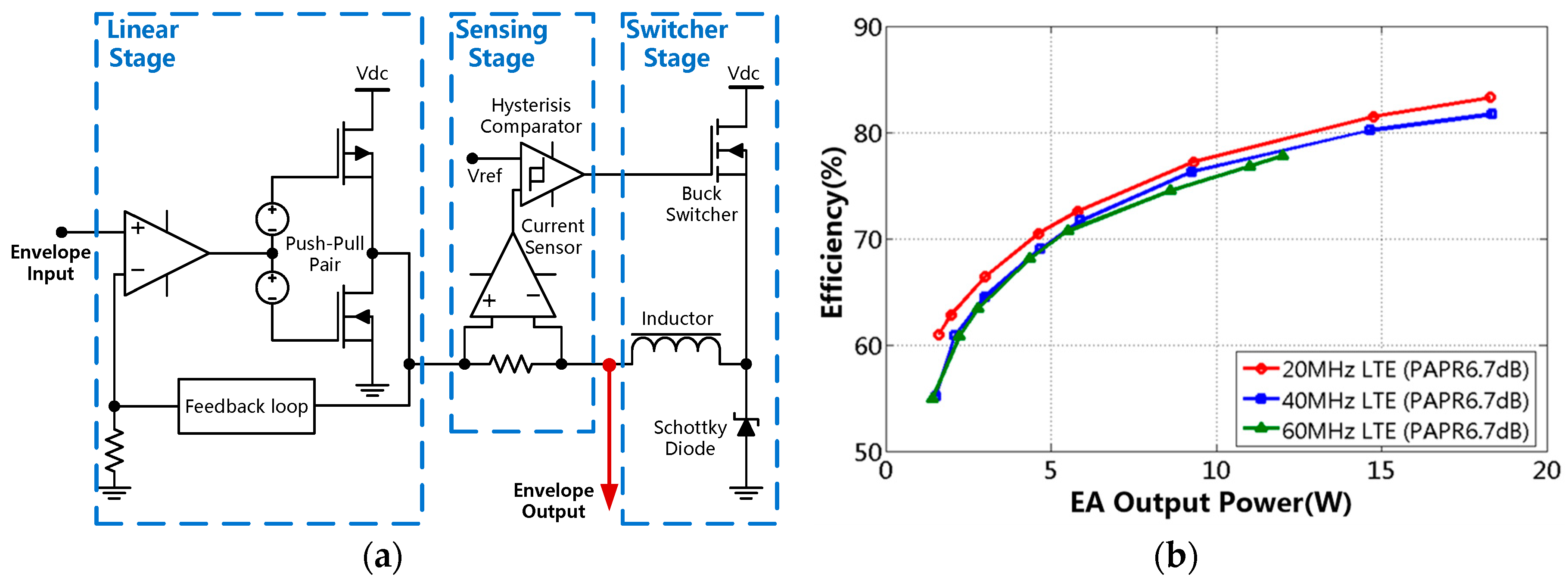

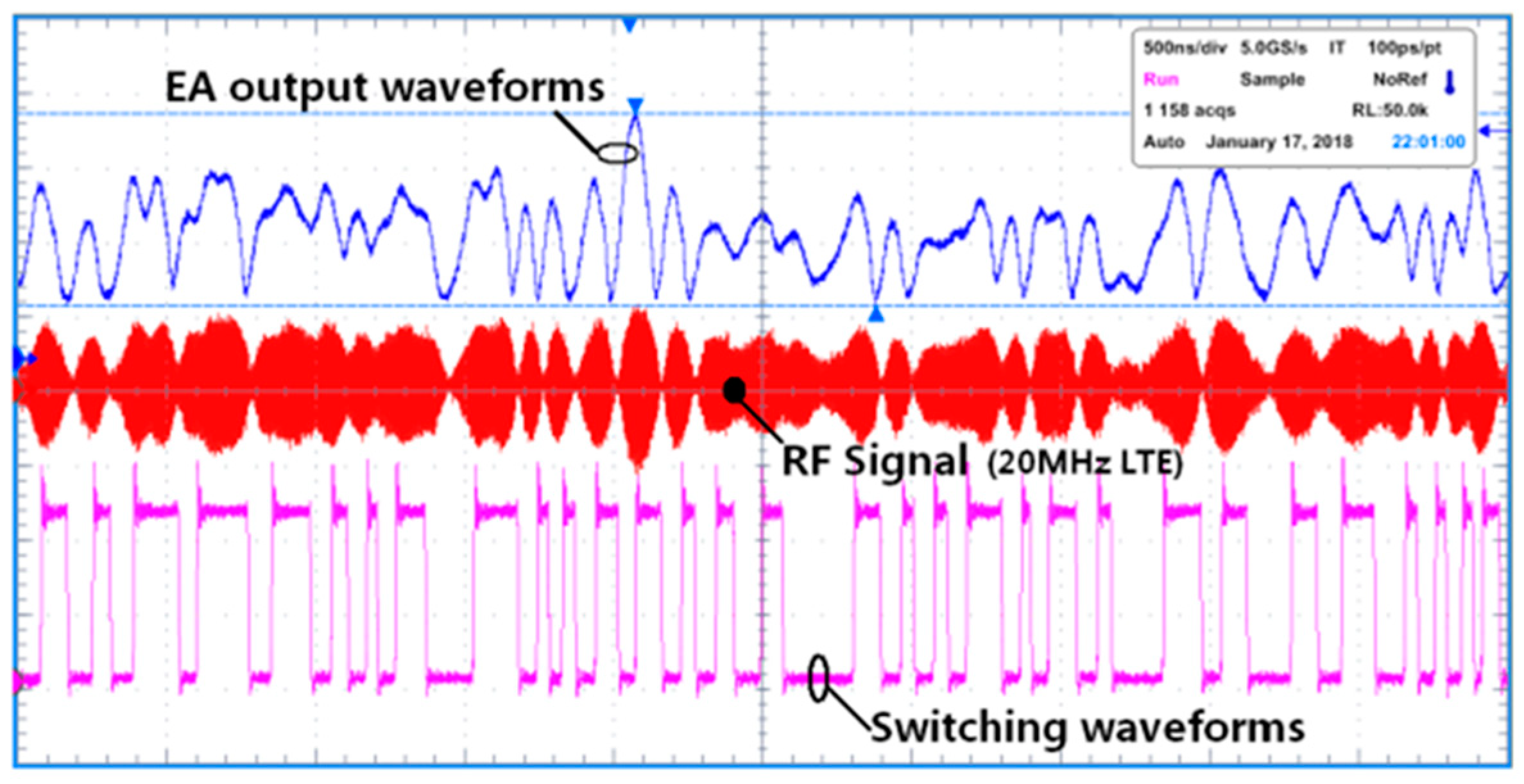
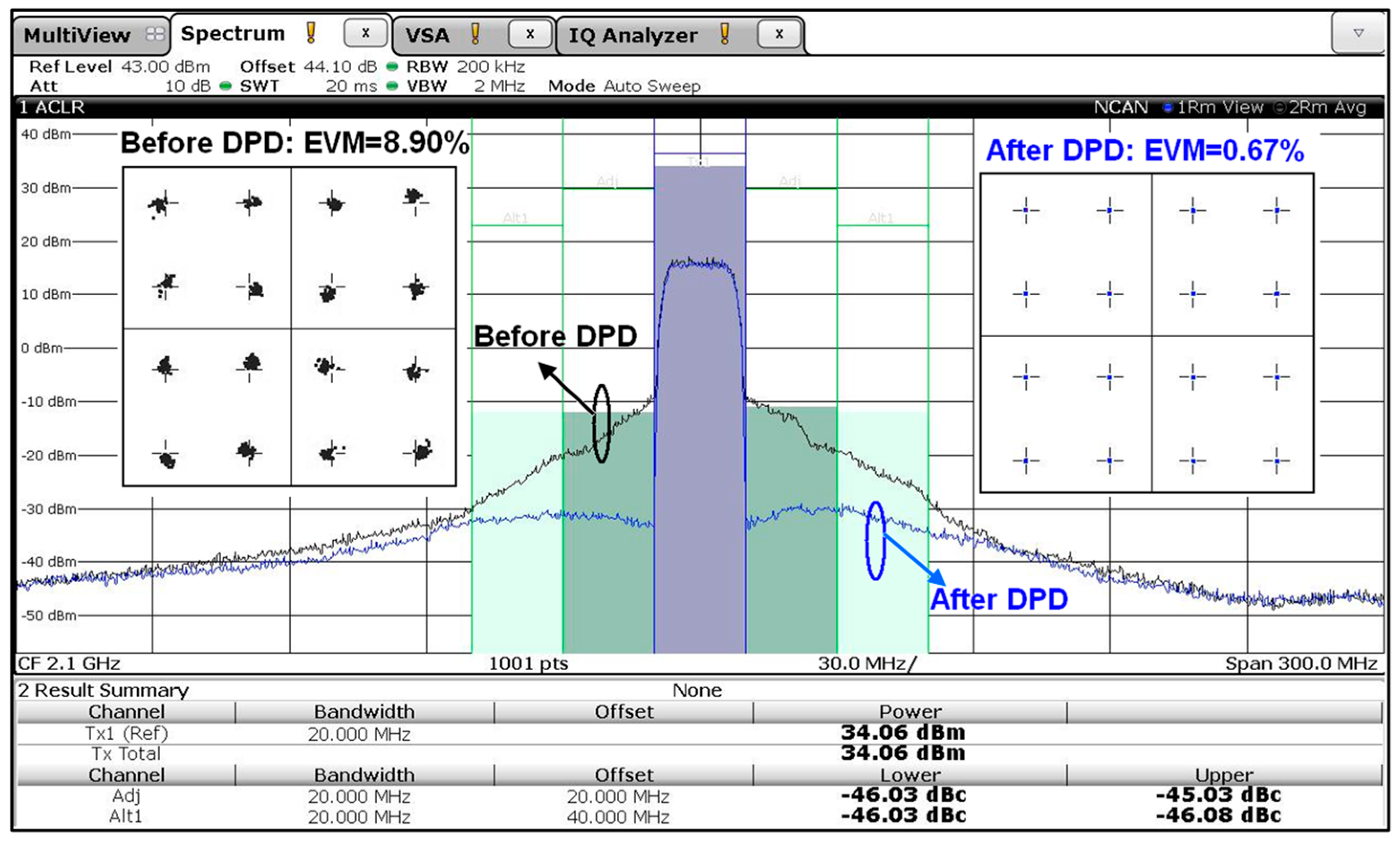
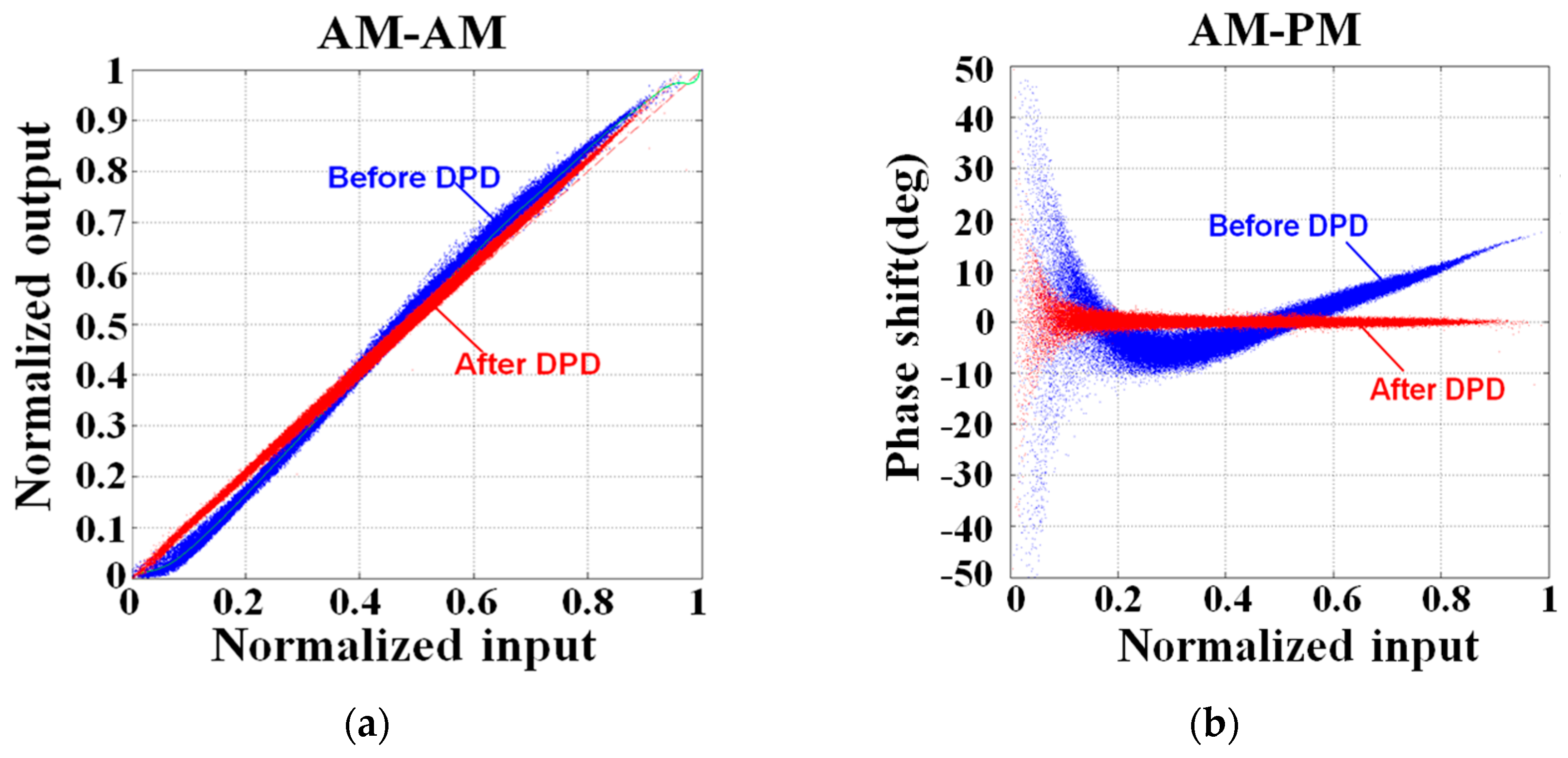
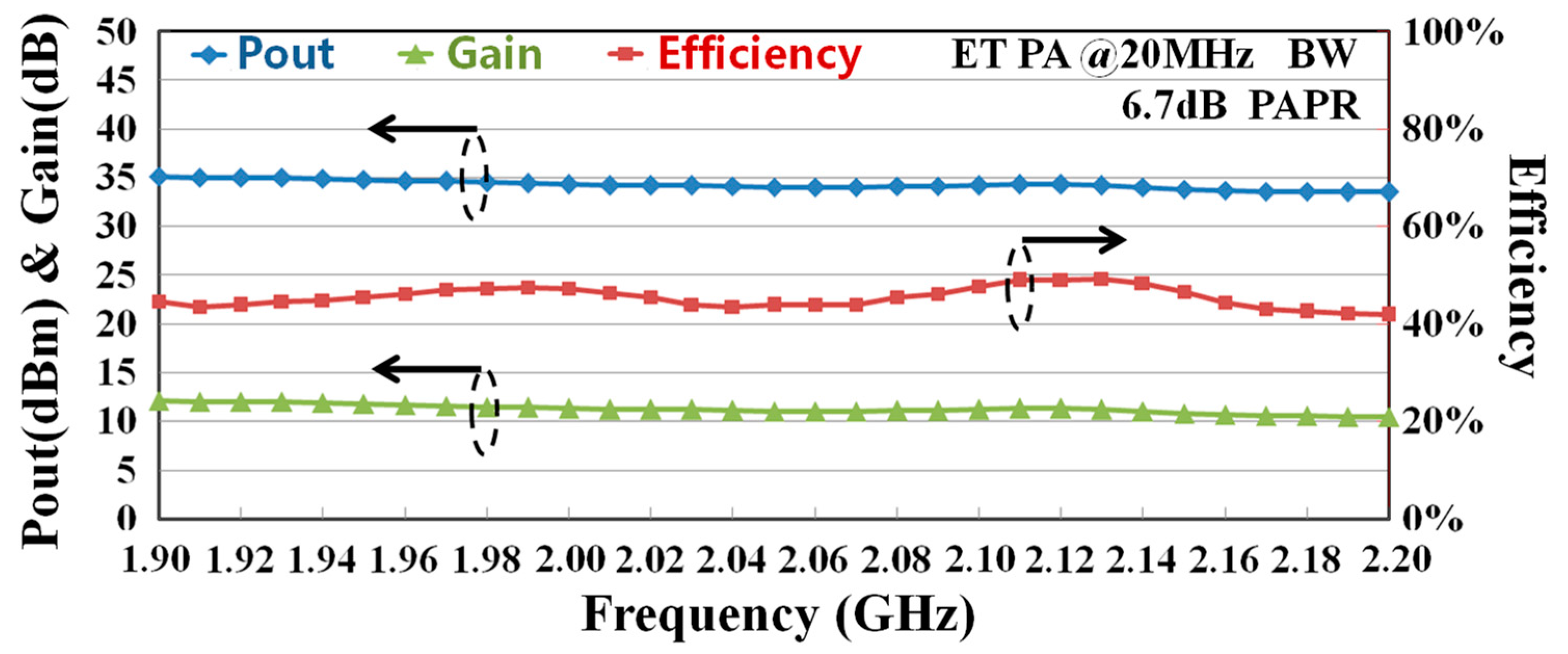
| PA Mode | Design Parameter | ||||
|---|---|---|---|---|---|
| Class-B | 15 V | 36 | 15.8 + 9.3j | 78.5% | 0.35 |
| Class-B | 20 V | 36 | 20.0 + 9.7j | 78.5% | 0.35 |
| Class-B | 30 V | 36 | 24.5 + 9.1j | 78.5% | 0.35 |
| Class-B/J | 15 V | 36 − 8.2j | 19.7 + 10.7j | 78.5% | 0.04 |
| Class-B/J | 20 V | 36 + 0.7j | 19.6 + 9.7j | 78.5% | 0.04 |
| Class-B/J | 30 V | 36 + 8.3j | 19.7 + 10.7j | 78.5% | 0.04 |
| Hybrid continuous modes (HCM) | 15 V | 41.6 − 4.9j | 16.9 + 12.3j | 89.9% | 0 |
| HCM | 20 V | 41.2 + 6.5j | 16.9 + 12.3j | 89.5% | 0 |
| HCM | 30 V | 36.6 + 14.4j | 16.9 + 12.3j | 79.7% | 0 |
| Ref. | Freq. (GHz) | Back Off (dB) | Pout (dBm) @ Low Supply | Power Added Efficiency (PAE) (%) @ Low Supply | Gain (dB) @ Low Supply |
|---|---|---|---|---|---|
| [12] | 2.68 | 7.0 | 34.5 | 50.1 | 10.2 |
| [13] | 1.85 | 7.5 | 22.5 | 46.0 | 9.5 |
| [14] | 3.6 | 6.5 | 32.5 | 68.5 | 12.3 |
| [15] | 1.8–2.7 | 8.0 | 35.0–36.3 | 59.0–65.0 | 8.0–11.0 |
| This work | 1.9–2.2 | 6.7 | 35.1–36.0 | 67.8–72.4 | 10.5–12.1 |
| Bandwidth (BW) (MHz) | Digital Pre-Distortion (DPD) | Pout (dBm) | Gain (dB) | Eff. (%) | ACLR1 (dBc) | Error Vector Magnitude (EVM) (%) |
|---|---|---|---|---|---|---|
| 5 | W/O | 34.4 | 11.0 | 61.3 | −26.7 | 7.50 |
| 5 | With | 34.4 | 11.0 | 60.8 | −49.7 | 0.32 |
| 10 | W/O | 34.6 | 11.1 | 56.7 | −26.8 | 8.10 |
| 10 | With | 34.2 | 10.7 | 53.7 | −46.3 | 0.60 |
| 20 | W/O | 34.3 | 11.3 | 46.4 | −26.4 | 8.90 |
| 20 | With | 34.1 | 11.1 | 44.1 | −46.0 | 0.67 |
© 2019 by the authors. Licensee MDPI, Basel, Switzerland. This article is an open access article distributed under the terms and conditions of the Creative Commons Attribution (CC BY) license (http://creativecommons.org/licenses/by/4.0/).
Share and Cite
Cao, T.; Liu, Y.; Chen, W.; Yang, C.; Zhou, J. Analytical Design Solution for Optimal Matching of Hybrid Continuous Mode Power Amplifiers Suitable for a High-Efficiency Envelope Tracking Operation. Electronics 2019, 8, 621. https://doi.org/10.3390/electronics8060621
Cao T, Liu Y, Chen W, Yang C, Zhou J. Analytical Design Solution for Optimal Matching of Hybrid Continuous Mode Power Amplifiers Suitable for a High-Efficiency Envelope Tracking Operation. Electronics. 2019; 8(6):621. https://doi.org/10.3390/electronics8060621
Chicago/Turabian StyleCao, Tao, Youjiang Liu, Wenhua Chen, Chun Yang, and Jie Zhou. 2019. "Analytical Design Solution for Optimal Matching of Hybrid Continuous Mode Power Amplifiers Suitable for a High-Efficiency Envelope Tracking Operation" Electronics 8, no. 6: 621. https://doi.org/10.3390/electronics8060621
APA StyleCao, T., Liu, Y., Chen, W., Yang, C., & Zhou, J. (2019). Analytical Design Solution for Optimal Matching of Hybrid Continuous Mode Power Amplifiers Suitable for a High-Efficiency Envelope Tracking Operation. Electronics, 8(6), 621. https://doi.org/10.3390/electronics8060621





